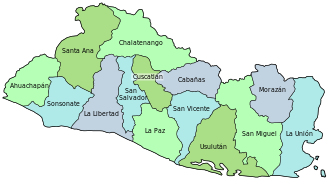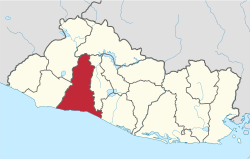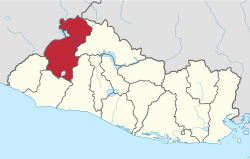Departments of El Salvador
| Departments of El Salvador | |
|---|---|
 | |
| Location | |
| Number | 14 |
| Populations |
|
| Areas | |
| Subdivisions | |
El Salvador is divided into 14 departments (Spanish: departamentos) for administrative purposes, subdivided into 44 municipalities (municipios) and 262 districts. The country is a unitary state.
History
[edit]June 12, 1824: The first Salvadoran constitution within the Federal Republic of Central America establishes a territorial division of four departments, Sonsonate, San Salvador, San Vicente, and San Miguel. Sonsonate was formerly part of Guatemala before this point.[1]
1833-1834: A short lived Department of Tejutla was established from the districts of Metapán and Tejutla in San Salvador.[2]
January 22, 1835: The Federal District of San Salvador is separated both from San Salvador department and from the State of Salvador. The remainder of San Salvador department is renamed to Cuscatlan, and Metapan district is transferred to Sonsonate department.[2][3]
May 17, 1839: Cuscatlán's Olocuitla district and San Vicente's Zacatecoluca district are combined into the new department of La Paz.[4]
July 30, 1839: The Federal District of San Salvador is dissolved, and San Salvador department is reconstituted, combining the former federal district with Opico district of Cuscatlan.[3]
March 15, 1847: La Paz department is abolished and reincorporated into San Vicente.[3]
February 21, 1852: La Paz department is restored.[3]
February 8, 1855: Santa Ana department is separated from Sonsonate.[4]
February 14, 1855: Chaltenango department is separated from Cuscatlán.[4]
January 26, 1865: La Libertad department is separated from San Salvador.[2][3]
June 22, 1865: Usulután and La Union departments are separated from San Miguel.[2][3]
February 12, 1869: Ahuachapán department is separated from Santa Ana.[2][3]
February 10, 1873: Cabañas department is created from parts of Cuscatlán and San Vicente.[2][3]
July 14, 1875: Gotera department is separated from San Miguel. It would be renamed to Morazán department on March 14, 1887.[2][3]
Departments
[edit]| Map | Flag | Coat of arms | Department | ISO Code | Capital | Area (km2) | Population (2024)[5] | Municipalities | Districts |
|---|---|---|---|---|---|---|---|---|---|

|

|
Ahuachapán | SV-AH | Ahuachapán | 1,239.6 | 348,880 | 3 | 12 | |

|
Cabañas | SV-CA | Sensuntepeque | 1,103.5 | 143,049 | 2 | 9 | ||

|
Chalatenango | SV-CH | Chalatenango | 2,016.6 | 185,930 | 3 | 33 | ||

|
Cuscatlán | SV-CU | Cojutepeque | 756.2 | 244,901 | 2 | 16 | ||

|

|
La Libertad | SV-LI | Santa Tecla | 1,652.9 | 765,879 | 6 | 22 | |

|
La Paz | SV-PA | Zacatecoluca | 1,223.6 | 318,374 | 3 | 22 | ||

|
La Unión | SV-UN | La Unión | 2,074.3 | 224,375 | 2 | 18 | ||

|
Morazán | SV-MO | San Francisco Gotera | 1,447.4 | 169,784 | 2 | 26 | ||

|

|
San Miguel | SV-SM | San Miguel | 2,077.1 | 447,634 | 3 | 20 | |

|

|
San Salvador | SV-SS | San Salvador | 886.2 | 1,563,371 | 5 | 19 | |

|

|
San Vicente | SV-SV | San Vicente | 1,184.0 | 161,857 | 2 | 13 | |

|

|
Santa Ana | SV-SA | Santa Ana | 2,023.2 | 552,938 | 4 | 13 | |

|
Sonsonate | SV-SO | Sonsonate | 1,225.2 | 470,455 | 4 | 16 | ||

|

|
Usulután | SV-US | Usulután | 2,130.4 | 325,494 | 3 | 23 |
See also
[edit]- List of cities in El Salvador
- Municipalities of El Salvador
- Geography of El Salvador
- List of Salvadoran departments by Human Development Index
- Department (country subdivision)
- ISO 3166-2:SV
References
[edit]- ^ "Constitución Política de la República de El Salvador de 1824 | Biblioteca Virtual Miguel de Cervantes". www.cervantesvirtual.com.
- ^ a b c d e f g Sistema de Información Territorial (2004). Viceministerio de Vivienda y Desarrollo Urbano (ed.). Poblamiento, ciudades, regiones y demarcaciones. Sistema de ciudades y demarcaciones territoriales a los efectos de planificación y desarrollo territorial. Plan Nacional de Ordenamiento y Desarrollo Territorial.
- ^ a b c d e f g h i Lardé y Larín, Jorge. Ministerio de Cultura (ed.). El Salvador: historia de sus pueblos, villas y ciudades.
- ^ a b c Menéndez, Isidro (1855). Recopilación de las Leyes del Salvador. Vol. Tomo I.
- ^ "VII Censo de Población y VI de Vivienda 2024 Características de la Población" [VII Census of the Population and VI of Housing 2024 Characteristics of the Population] (PDF). Government of El Salvador (in Spanish). 2024. Archived from the original (PDF) on 5 April 2025. Retrieved 19 April 2025.
